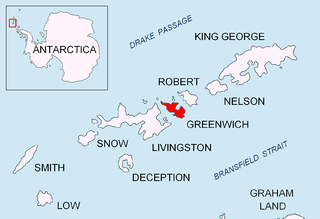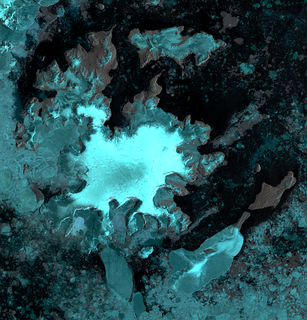
Thurston Island is an ice-covered, glacially dissected island, 215 km (134 mi) long, 90 km (56 mi) wide and 15,700 km2 (6,062 sq mi) in area, lying a short way off the northwest end of Ellsworth Land, Antarctica. It is the third largest island of Antarctica, after Alexander Island and Berkner Island.

Dundee Island is an ice-covered island lying east of the northeastern tip of Antarctic Peninsula and south of Joinville Island.

The Clerke Rocks are a group of small rocky islands some 35 miles (56 km) southeast of South Georgia that extend 5 miles (8.0 km) from east to west. The Clerke Rocks include The Office Boys at the northeastern end and Nobby at the southeastern end of the group. The islands belong to the British Overseas Territory of South Georgia and the South Sandwich Islands and are also claimed by Argentina as part of Tierra del Fuego Province.

Lützow-Holm Bay is a large bay, about 220 kilometres (120 nmi) wide, indenting the coast of Queen Maud Land in Antarctica between Riiser-Larsen Peninsula and the coastal angle immediately east of the Flatvaer Islands. It was discovered by Captain Hjalmar Riiser-Larsen in two airplane flights from his expedition vessel, the Norvegia, on February 21 and 23, 1931. The name honours Commander Finn Lützow-Holm of the Royal Norwegian Navy Air Service, a pilot for Captain Riiser-Larsen on the Aagaard in 1935.

Snow Hill Island is an almost completely snowcapped island, 33 km (21 mi) long and 12 km (7.5 mi) wide, lying off the east coast of the Antarctic Peninsula. It is separated from James Ross Island to the north-east by Admiralty Sound and from Seymour Island to the north by Picnic Passage. It is one of several islands around the peninsula known as Graham Land, which is closer to South America than any other part of the Antarctic continent.

Yoke Island, known also as Islotes Los Provincianos is an island lying west of the north end of Liège Island in the Palmer Archipelago. Charted by the French Antarctic Expedition under Charcot, 1903-05. The name given by the United Kingdom Antarctic Place-Names Committee (UK-APC) in 1960 is descriptive of the shape of the island in both plan and elevation.

The Ibar Rocks are two rocks located 0.4 kilometres (0.2 nmi) east of Bonert Rock and 1 kilometre (0.6 nmi) southeast of Canto Point, Greenwich Island, in the South Shetland Islands. The names "Islote Ibar" and "Islote Teniente Ibar" appearing on Chilean hydrographic charts in the 1950s refer to the larger and western rock. The recommended name "Ibar Rocks" includes a submerged outlier to the northeast of the larger rock. Teniente (lieutenant) Mario Ibar P. signed the official act of inauguration of the Chilean Captain Arturo Prat Base on Greenwich Island in 1947.
The Acuña Rocks, also known as Islote Acuña, are a pair of rocks lying 0.4 miles (0.6 km) west of Largo Island in the Duroch Islands, off Cape Legoupil, Trinity Peninsula. They were named by the Chilean Antarctic Expedition, 1947–48, after Sub-Teniente Acuña, a member of the expedition.
Agurto Rock, also variously known as Islote Agurto, Isla Elena Cerda de Bulnes or Isla Elena, is a rock lying just northwest of Silvia Rock in the Duroch Islands, Trinity Peninsula. The name appears on a Chilean government chart of 1959.

The Chatos Islands are a group of small islands and rocks lying south of Cape Adriasola, Adelaide Island. The descriptive name Islotes Chatos was given by the Argentine Antarctic Expedition of 1952–53.

Cono Island is a conspicuous conical island lying south of the Chatos Islands, off the southwest part of Adelaide Island. The feature was descriptively named Islote Cono by the Argentine Antarctic Expedition of 1952–53.
Fuente Rock is a low rock surmounted by a navigational beacon, 0.4 nautical miles (0.7 km) northeast of Ferrer Point in Discovery Bay, Greenwich Island, South Shetland Islands. The name derives from the form "Islote de la Fuente" appearing on a Chilean hydrographic chart of 1951.

Emm Rock is a conspicuous rock 30 metres (100 ft) high, lying 0.5 nautical miles (1 km) off the south coast of King George Island at the east side of the entrance to Potter Cove, in the South Shetland Islands. This rock, presumably known to early sealers in the area, was sketched by the French Antarctic Expedition, 1908–10, under Jean-Baptiste Charcot, and charted by Discovery Investigations personnel on the Discovery II in 1935. The name derives from the shape of the rock, which resembles the letter M.

Link Island is a small island at the outer (northern) margin of the Duroch Islands, approximately 6 kilometres (3 nmi) northwest of Halpern Point, Trinity Peninsula, Antarctica. The island was charted by the Chilean Antarctic Expedition, 1947–48, and called "Islote Sub-Teniente Ross" or "Islote Ross." The Advisory Committee on Antarctic Names named it after David A. Link, a field assistant with the University of Wisconsin geological party during reconnaissance of this area, 1960–61, this name avoiding possible confusion with James Ross Island.

Hobbs Glacier is a glacier situated in a steep, rock-walled cirque at the northwest side of Hamilton Point, and flowing southeast into the southern part of Markham Bay on the east coast of James Ross Island, Antarctica. It was first seen and surveyed by the Swedish Antarctic Expedition, 1901–04, under Otto Nordenskiöld, who named it for Professor William H. Hobbs, an American geologist and glaciologist.
Sanavirón Island is an island lying off Northeast Glacier, southeast of Audrey Island, Debenham Islands, in Marguerite Bay on the Fallières Coast. It was charted by the Argentine Antarctic Expedition, 1950–51, as two small islands and named "Islotes Sanavirón" after the Argentine ship Sanavirón, which was used for the hydrographic survey of the area. The feature has been determined to be a single island.
Tenorio Rock is a rock 0.4 nautical miles (0.7 km) offshore in western Discovery Bay, Greenwich Island, South Shetland Islands. The name derives from the forms "Islote Tenorio" and "Islote Aviador Tenorio" used on Chilean hydrographic charts of the 1950s. Humbert Tenorio Island was second pilot of the Sikorsky helicopter employed by the Chilean Antarctic Expedition of 1947.
Romero Rock is a rock lying 0.1 nautical miles (0.2 km) west of Saavedra Rock in the Duroch Islands, Trinity Peninsula. The Chilean Antarctic Expedition of 1947-48, under the command of Navy Captain Ernesto Gonzalez Navarrete, made a survey of this area and gave the name "Islote Astronomo Romero" after Astronomer of the Chilean Army Guillermo Romero Gonzalez who was a member of the expedition and did astronomical work in the Antarctic. Around 1951 the name "Islote Romero" began to be used to avoid the compound name. The present name, Romero Rock, has been in use since 1962.

Lemaire Island is an island 4.5 nautical miles (8 km) long and 1.5 nautical miles (3 km) wide, lying 1 nautical mile (2 km) west of Duthiers Point off the west coast of Graham Land, Antarctica. It was discovered by the Belgian Antarctic Expedition, 1897–99, under Adrien de Gerlache, who named it for Charles Antoine Lemaire. The island is bordered by the Aguirre Passage which separates it from the Danco Coast.














